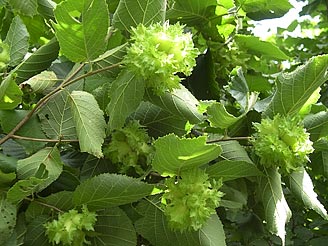Hazelnuts
There are two main varieties of hazelnuts in North America; the beaked hazels stretch across the northern United States and parts of Canada…while the American hazelnut rules these Midwestern parts and is what you will want to (officially) look up if you would like to do more research before collecting—from this point forward, I’ll simply refer to these beauts as hazelnuts.
My first experience collecting hazelnuts was over a decade ago. I was staying with a friend at (her great uncle) John’s house in Kentucky and we rode in the back of a pickup to a sweet stand of 10-or-so foot tall (thick foliaged and shrub-like) trees. I remember the clusters of funky looking ‘leaves.’ Carefully prying these leaves apart revealed a brown, smooth-shelled nut. I cannot recall how we cracked open these small hazelnuts that day, but I DO remember how incredibly delicious they were fresh from the tree……
Hazelnut trees, range from 8 to 12 feet tall and contain green, round’ish (almost heart-shaped), alternate leaves. The leaves are 8–12 cm long and 4–8 cm wide, are serrated, have pointed tips and a backside that is a bit lighter in color than the front. They are often found in old-growth woodlands as an understory shrub~ especially growing well in areas that have opened up due to fire, logging or the like. This tree/shrub also grows well and is easily found along riverbanks, abandoned fields and woodland edges. The nuts themselves will be covered in a leafy green shell (sheaths) and are typically found in clusters of 3. Due to their bountiful nature, hazels are an important wildlife food in North America. They are enjoyed by squirrels, mice and chipmunks…bears nosh on both nuts and sheathing, packing on the weight for the winter months, and deer browse on hazelnut twigs.
Nutritionally, hazelnuts would be a ‘must find’ food if you ever found yourself lost in a forest. Few foods would be as sustaining~ due both to their ease of collection and caloric abundance. Hazels are rich in beneficial oils, protein, fiber, the B spectrum of vitamins, vitamin E and minerals (manganese, potassium, calcium, copper, iron, magnesium, zinc and selenium). That they are so agreeable, taste-wise, is also worth a mention;).
I’ve only enjoyed a handful of opportunities to collect hazelnuts since my first experience on ‘Uncle John’s’ farm, but I’ve learned enough for successful gatherings. When collecting hazelnuts~ twist the entire cluster from the tree, being careful to avoid pulling off the whole twig as well. The riper the nuts are, the easier it is to separate them from their leaf shells. If the nuts are already ripe, they can be removed from the sheathing by pulling both it and the base (called bracts or involucre– just below the flower, connecting to the stalk) apart and pushing the nut out. If it does not detach easily, it may not be ripe and/or the kernel may be bad. The nuts can also be spread out to dry (where they cannot be easily discovered by critters;)) for about a week or so—or until the base (bracts) turn brown allowing the nut to become a bit easier to remove from the shell.
After the nuts are separated from their sheaths-> it is time to crack and eat!!! The nuts can be cracked with a traditional nutcracker (though their small size can make this a tedious task depending on the size of the cracker) or by using a hammer. When using a hammer to crack nuts, I like to either place the nuts in a bag or between two towels to keep the pieces from flying everywhere. Hazelnut meat can, then, be easily picked out by hand. While the flavor of fresh hazelnuts is, in my opinion, unbeatable~ they can be stored, both at room and cold temperatures, for fairly long periods of time.
Hazelnut Milk
In a high-speed blender, blend 1 cup of hazelnuts with 3 cups of spring or filtered water. Strain the mixture through a nut milk bag or a fine mesh colander. Enjoy as is, or add in flavors– such as vanilla, stevia, dash of sea salt, cinnamon, etc..
Pear and Hazel Torte
Crust:
- 2 cups hazelnuts, finely ground in food processor or coffee grinder
- 3 tablespoons high quality coconut oil or ghee
- 1 dropperful vanilla stevia (or 1-2 tablespoons of other natural sweetener—honey, maple syrup, etc..)
- 1 tsp. sea salt
In a bowl, mix together above ingredients until crumble-like, press into a pie pan.
Cream:
- 2 cups of coconut yogurt/kefir, coconut cream or traditional yogurt
- 1 dropperful vanilla stevia (or a dash of vanilla along with 1-2 tablespoons of other natural sweetener—honey, maple syrup, etc..)
Pour into crust, and top with slices of fresh pear and sprinkles of cinnamon.
(village voice, 2011)

